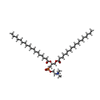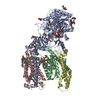+Search query
-Structure paper
| Title | Preferential Regulation of Γ-Secretase-Mediated Cleavage of APP by Ganglioside GM1 Reveals a Potential Therapeutic Target for Alzheimer's Disease. |
|---|---|
| Journal, issue, pages | Adv Sci (Weinh), Vol. 10, Issue 32, Page e2303411, Year 2023 |
| Publish date | Sep 27, 2023 |
 Authors Authors | Xiaotong Wang / Rui Zhou / Xiaqin Sun / Jun Li / Jinxin Wang / Weihua Yue / Lifang Wang / Hesheng Liu / Yigong Shi / Dai Zhang /  |
| PubMed Abstract | A hallmark of Alzheimer's disease (AD) is the senile plaque, which contains β-amyloid peptides (Aβ). Ganglioside GM1 is the most common brain ganglioside. However, the mechanism of GM1 in ...A hallmark of Alzheimer's disease (AD) is the senile plaque, which contains β-amyloid peptides (Aβ). Ganglioside GM1 is the most common brain ganglioside. However, the mechanism of GM1 in modulating Aβ processing is rarely known. Aβ levels are detected by using Immunohistochemistry (IHC) and enzyme-linked immune-sorbent assay (ELISA). Cryo-electron microscopy (Cryo-EM) is used to determine the structure of γ-secretase supplemented with GM1. The levels of the cleavage of amyloid precursor protein (APP)/Cadherin/Notch1 are detected using Western blot analysis. Y maze, object translocation, and Barnes maze are performed to evaluate cognitive functions. GM1 leads to conformational change of γ-secretase structure and specifically accelerates γ-secretase cleavage of APP without affecting other substrates including Notch1, potentially through its interaction with the N-terminal fragment of presenilin 1 (PS1). Reduction of GM1 levels decreases amyloid plaque deposition and improves cognitive dysfunction. This study reveals the mechanism of GM1 in Aβ generation and provides the evidence that decreasing GM1 levels represents a potential strategy in AD treatment. These results provide insights into the detailed mechanism of the effect of GM1 on PS1, representing a step toward the characterization of its novel role in the modulation of γ-secretase activity and the pathogenesis of AD. |
 External links External links |  Adv Sci (Weinh) / Adv Sci (Weinh) /  PubMed:37759382 / PubMed:37759382 /  PubMed Central PubMed Central |
| Methods | EM (single particle) |
| Resolution | 3.4 Å |
| Structure data | EMDB-35572, PDB-8im7: |
| Chemicals |  ChemComp-NAG:  ChemComp-PC1:  ChemComp-CLR: |
| Source |
|
 Keywords Keywords |  MEMBRANE PROTEIN / MEMBRANE PROTEIN /  intramembrane protease / intramembrane protease /  lipid / lipid /  ganglioside / ganglioside /  GM1 GM1 |
 Movie
Movie Controller
Controller Structure viewers
Structure viewers About Yorodumi Papers
About Yorodumi Papers






